Leadership in Workplace: Research Report on Styles, Traits, and Impact
VerifiedAdded on 2020/04/29
|12
|2959
|70
Report
AI Summary
This research report provides a comprehensive overview of leadership in the workplace, exploring its significance in organizational culture and employee development. The report delves into various leadership styles, including primal, democratic, coaching, charismatic, authoritative, and coercive, highlighting their characteristics and impact on employee performance and satisfaction. It further examines essential leadership traits such as honesty, emotional stability, and positive attitude. The report contrasts leadership theories with real-world scenarios, addressing biases, miscommunication, and misuse of authority. The author concludes with key learnings, emphasizing the importance of a positive attitude, understanding the team, fostering a conducive environment, and developing future leaders. The report underscores the critical role of effective leadership in driving organizational success and employee growth.
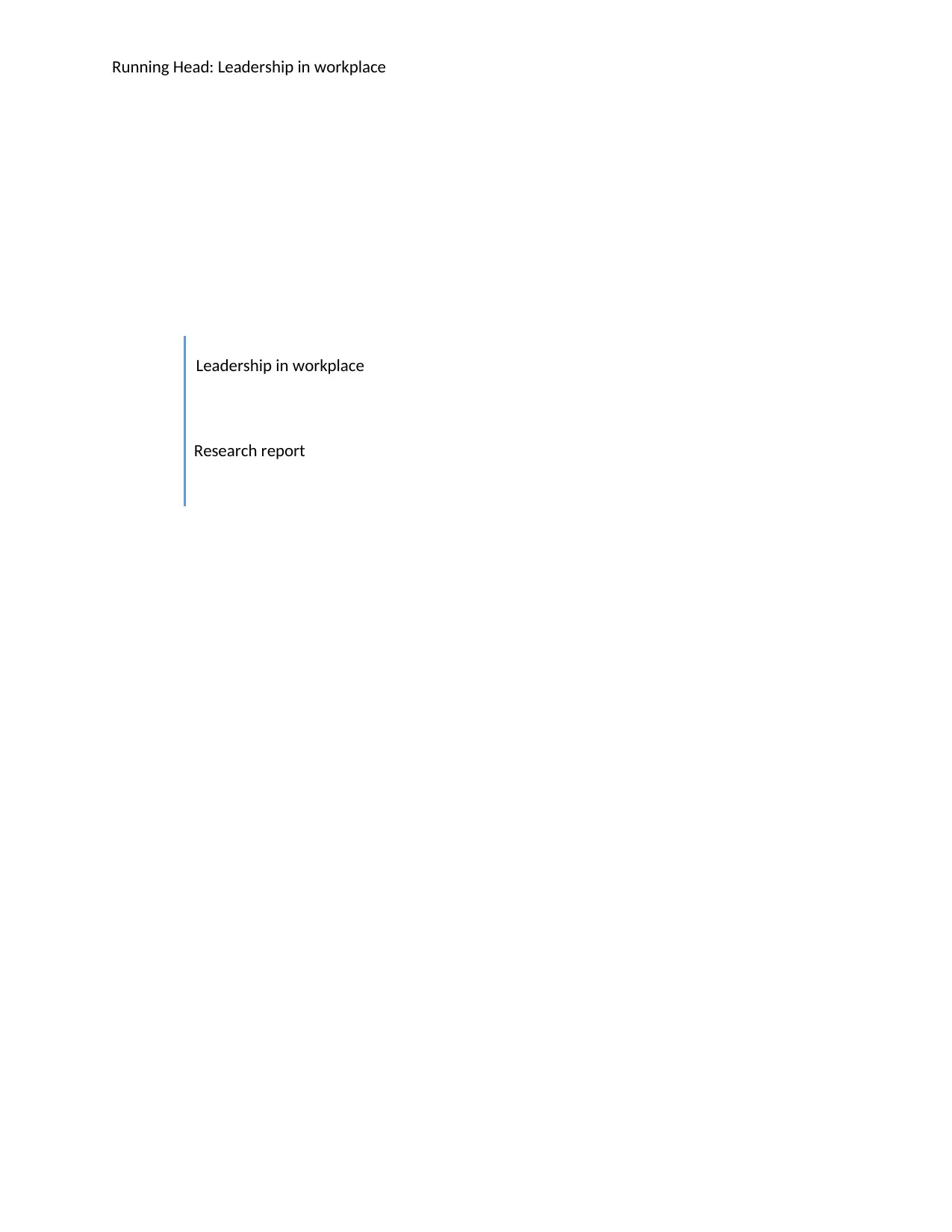
Running Head: Leadership in workplace
Leadership in workplace
Research report
Leadership in workplace
Research report
Paraphrase This Document
Need a fresh take? Get an instant paraphrase of this document with our AI Paraphraser
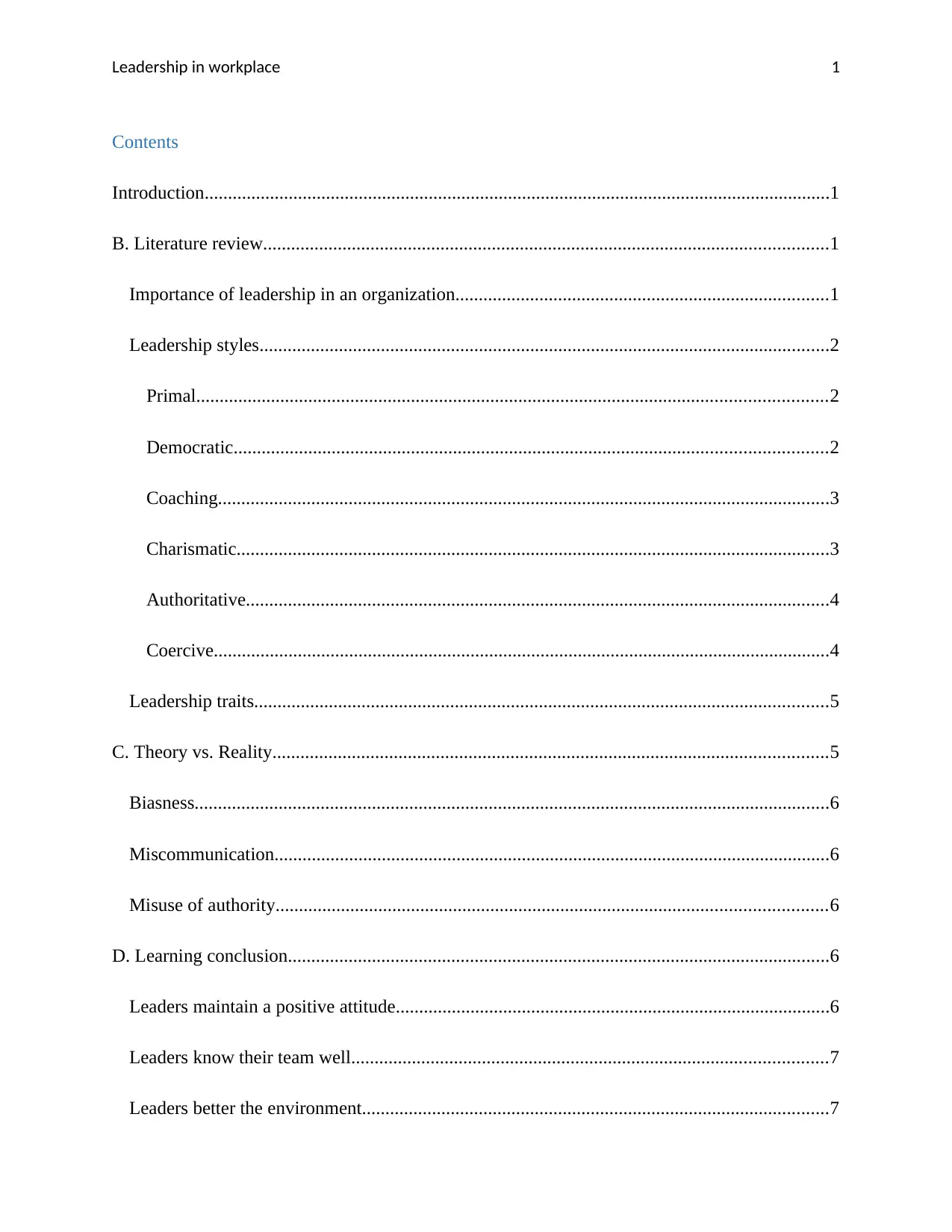
Leadership in workplace 1
Contents
Introduction......................................................................................................................................1
B. Literature review.........................................................................................................................1
Importance of leadership in an organization................................................................................1
Leadership styles..........................................................................................................................2
Primal.......................................................................................................................................2
Democratic...............................................................................................................................2
Coaching...................................................................................................................................3
Charismatic...............................................................................................................................3
Authoritative.............................................................................................................................4
Coercive....................................................................................................................................4
Leadership traits...........................................................................................................................5
C. Theory vs. Reality.......................................................................................................................5
Biasness........................................................................................................................................6
Miscommunication.......................................................................................................................6
Misuse of authority......................................................................................................................6
D. Learning conclusion....................................................................................................................6
Leaders maintain a positive attitude.............................................................................................6
Leaders know their team well......................................................................................................7
Leaders better the environment....................................................................................................7
Contents
Introduction......................................................................................................................................1
B. Literature review.........................................................................................................................1
Importance of leadership in an organization................................................................................1
Leadership styles..........................................................................................................................2
Primal.......................................................................................................................................2
Democratic...............................................................................................................................2
Coaching...................................................................................................................................3
Charismatic...............................................................................................................................3
Authoritative.............................................................................................................................4
Coercive....................................................................................................................................4
Leadership traits...........................................................................................................................5
C. Theory vs. Reality.......................................................................................................................5
Biasness........................................................................................................................................6
Miscommunication.......................................................................................................................6
Misuse of authority......................................................................................................................6
D. Learning conclusion....................................................................................................................6
Leaders maintain a positive attitude.............................................................................................6
Leaders know their team well......................................................................................................7
Leaders better the environment....................................................................................................7

Leadership in workplace 2
Leaders build the next generation leaders....................................................................................7
References........................................................................................................................................8
Leaders build the next generation leaders....................................................................................7
References........................................................................................................................................8
⊘ This is a preview!⊘
Do you want full access?
Subscribe today to unlock all pages.

Trusted by 1+ million students worldwide
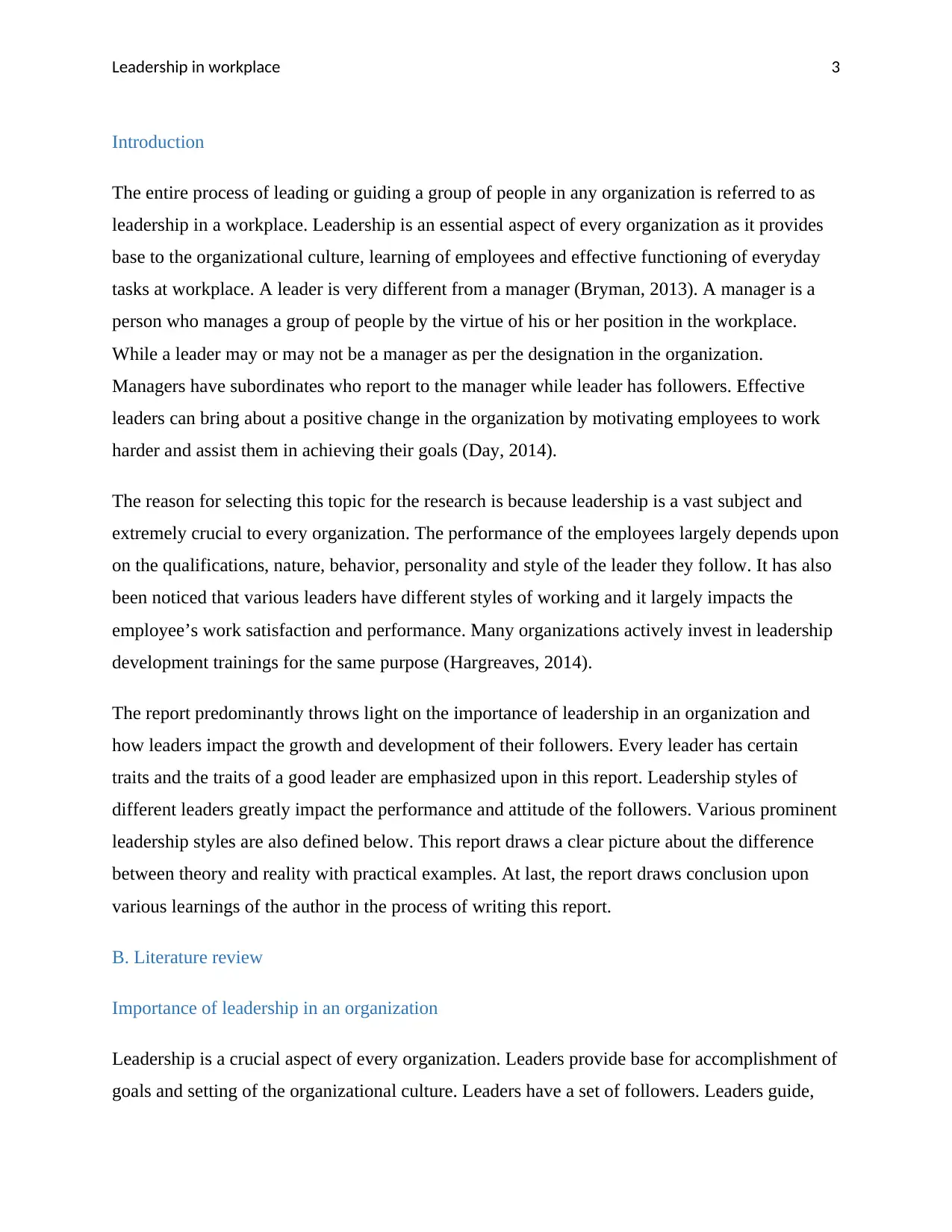
Leadership in workplace 3
Introduction
The entire process of leading or guiding a group of people in any organization is referred to as
leadership in a workplace. Leadership is an essential aspect of every organization as it provides
base to the organizational culture, learning of employees and effective functioning of everyday
tasks at workplace. A leader is very different from a manager (Bryman, 2013). A manager is a
person who manages a group of people by the virtue of his or her position in the workplace.
While a leader may or may not be a manager as per the designation in the organization.
Managers have subordinates who report to the manager while leader has followers. Effective
leaders can bring about a positive change in the organization by motivating employees to work
harder and assist them in achieving their goals (Day, 2014).
The reason for selecting this topic for the research is because leadership is a vast subject and
extremely crucial to every organization. The performance of the employees largely depends upon
on the qualifications, nature, behavior, personality and style of the leader they follow. It has also
been noticed that various leaders have different styles of working and it largely impacts the
employee’s work satisfaction and performance. Many organizations actively invest in leadership
development trainings for the same purpose (Hargreaves, 2014).
The report predominantly throws light on the importance of leadership in an organization and
how leaders impact the growth and development of their followers. Every leader has certain
traits and the traits of a good leader are emphasized upon in this report. Leadership styles of
different leaders greatly impact the performance and attitude of the followers. Various prominent
leadership styles are also defined below. This report draws a clear picture about the difference
between theory and reality with practical examples. At last, the report draws conclusion upon
various learnings of the author in the process of writing this report.
B. Literature review
Importance of leadership in an organization
Leadership is a crucial aspect of every organization. Leaders provide base for accomplishment of
goals and setting of the organizational culture. Leaders have a set of followers. Leaders guide,
Introduction
The entire process of leading or guiding a group of people in any organization is referred to as
leadership in a workplace. Leadership is an essential aspect of every organization as it provides
base to the organizational culture, learning of employees and effective functioning of everyday
tasks at workplace. A leader is very different from a manager (Bryman, 2013). A manager is a
person who manages a group of people by the virtue of his or her position in the workplace.
While a leader may or may not be a manager as per the designation in the organization.
Managers have subordinates who report to the manager while leader has followers. Effective
leaders can bring about a positive change in the organization by motivating employees to work
harder and assist them in achieving their goals (Day, 2014).
The reason for selecting this topic for the research is because leadership is a vast subject and
extremely crucial to every organization. The performance of the employees largely depends upon
on the qualifications, nature, behavior, personality and style of the leader they follow. It has also
been noticed that various leaders have different styles of working and it largely impacts the
employee’s work satisfaction and performance. Many organizations actively invest in leadership
development trainings for the same purpose (Hargreaves, 2014).
The report predominantly throws light on the importance of leadership in an organization and
how leaders impact the growth and development of their followers. Every leader has certain
traits and the traits of a good leader are emphasized upon in this report. Leadership styles of
different leaders greatly impact the performance and attitude of the followers. Various prominent
leadership styles are also defined below. This report draws a clear picture about the difference
between theory and reality with practical examples. At last, the report draws conclusion upon
various learnings of the author in the process of writing this report.
B. Literature review
Importance of leadership in an organization
Leadership is a crucial aspect of every organization. Leaders provide base for accomplishment of
goals and setting of the organizational culture. Leaders have a set of followers. Leaders guide,
Paraphrase This Document
Need a fresh take? Get an instant paraphrase of this document with our AI Paraphraser
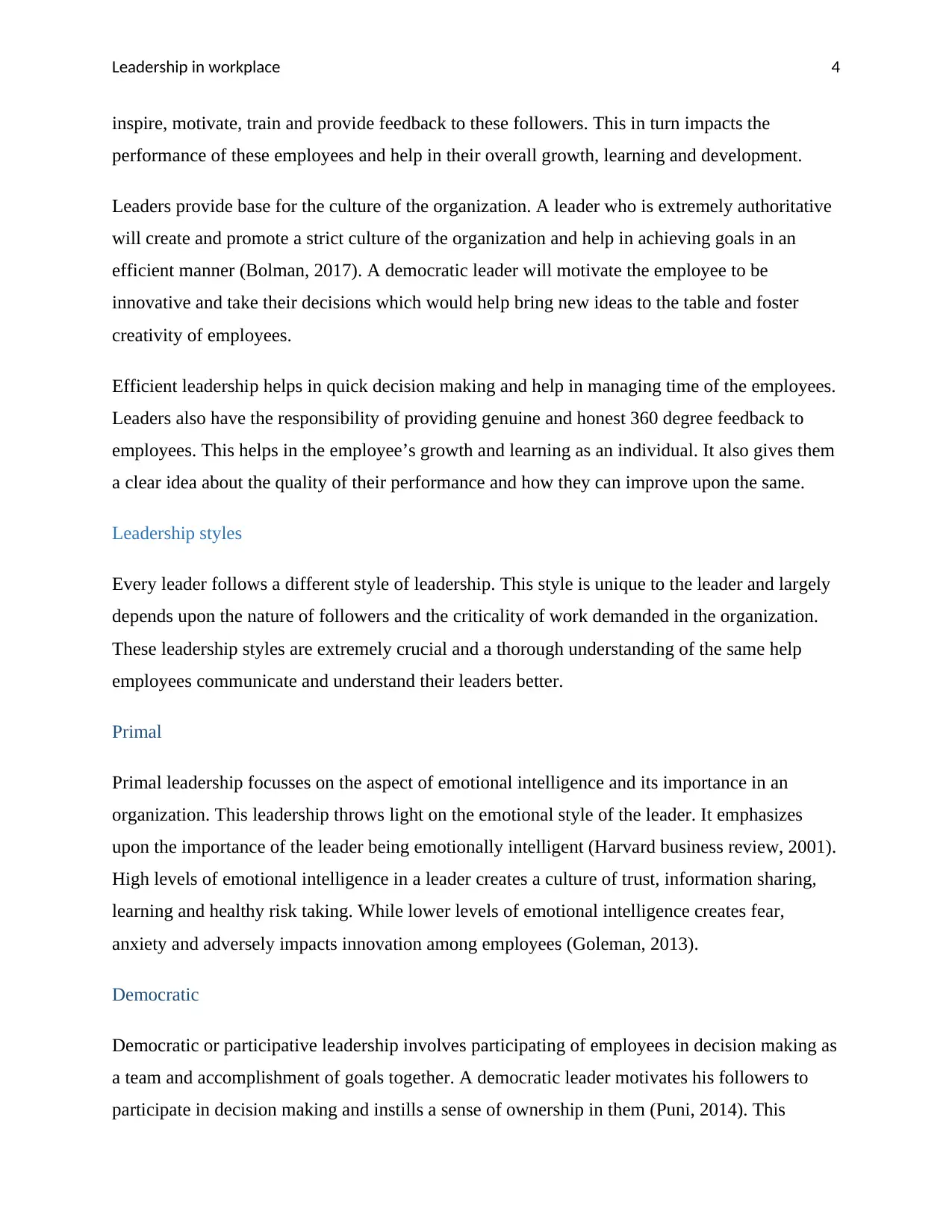
Leadership in workplace 4
inspire, motivate, train and provide feedback to these followers. This in turn impacts the
performance of these employees and help in their overall growth, learning and development.
Leaders provide base for the culture of the organization. A leader who is extremely authoritative
will create and promote a strict culture of the organization and help in achieving goals in an
efficient manner (Bolman, 2017). A democratic leader will motivate the employee to be
innovative and take their decisions which would help bring new ideas to the table and foster
creativity of employees.
Efficient leadership helps in quick decision making and help in managing time of the employees.
Leaders also have the responsibility of providing genuine and honest 360 degree feedback to
employees. This helps in the employee’s growth and learning as an individual. It also gives them
a clear idea about the quality of their performance and how they can improve upon the same.
Leadership styles
Every leader follows a different style of leadership. This style is unique to the leader and largely
depends upon the nature of followers and the criticality of work demanded in the organization.
These leadership styles are extremely crucial and a thorough understanding of the same help
employees communicate and understand their leaders better.
Primal
Primal leadership focusses on the aspect of emotional intelligence and its importance in an
organization. This leadership throws light on the emotional style of the leader. It emphasizes
upon the importance of the leader being emotionally intelligent (Harvard business review, 2001).
High levels of emotional intelligence in a leader creates a culture of trust, information sharing,
learning and healthy risk taking. While lower levels of emotional intelligence creates fear,
anxiety and adversely impacts innovation among employees (Goleman, 2013).
Democratic
Democratic or participative leadership involves participating of employees in decision making as
a team and accomplishment of goals together. A democratic leader motivates his followers to
participate in decision making and instills a sense of ownership in them (Puni, 2014). This
inspire, motivate, train and provide feedback to these followers. This in turn impacts the
performance of these employees and help in their overall growth, learning and development.
Leaders provide base for the culture of the organization. A leader who is extremely authoritative
will create and promote a strict culture of the organization and help in achieving goals in an
efficient manner (Bolman, 2017). A democratic leader will motivate the employee to be
innovative and take their decisions which would help bring new ideas to the table and foster
creativity of employees.
Efficient leadership helps in quick decision making and help in managing time of the employees.
Leaders also have the responsibility of providing genuine and honest 360 degree feedback to
employees. This helps in the employee’s growth and learning as an individual. It also gives them
a clear idea about the quality of their performance and how they can improve upon the same.
Leadership styles
Every leader follows a different style of leadership. This style is unique to the leader and largely
depends upon the nature of followers and the criticality of work demanded in the organization.
These leadership styles are extremely crucial and a thorough understanding of the same help
employees communicate and understand their leaders better.
Primal
Primal leadership focusses on the aspect of emotional intelligence and its importance in an
organization. This leadership throws light on the emotional style of the leader. It emphasizes
upon the importance of the leader being emotionally intelligent (Harvard business review, 2001).
High levels of emotional intelligence in a leader creates a culture of trust, information sharing,
learning and healthy risk taking. While lower levels of emotional intelligence creates fear,
anxiety and adversely impacts innovation among employees (Goleman, 2013).
Democratic
Democratic or participative leadership involves participating of employees in decision making as
a team and accomplishment of goals together. A democratic leader motivates his followers to
participate in decision making and instills a sense of ownership in them (Puni, 2014). This
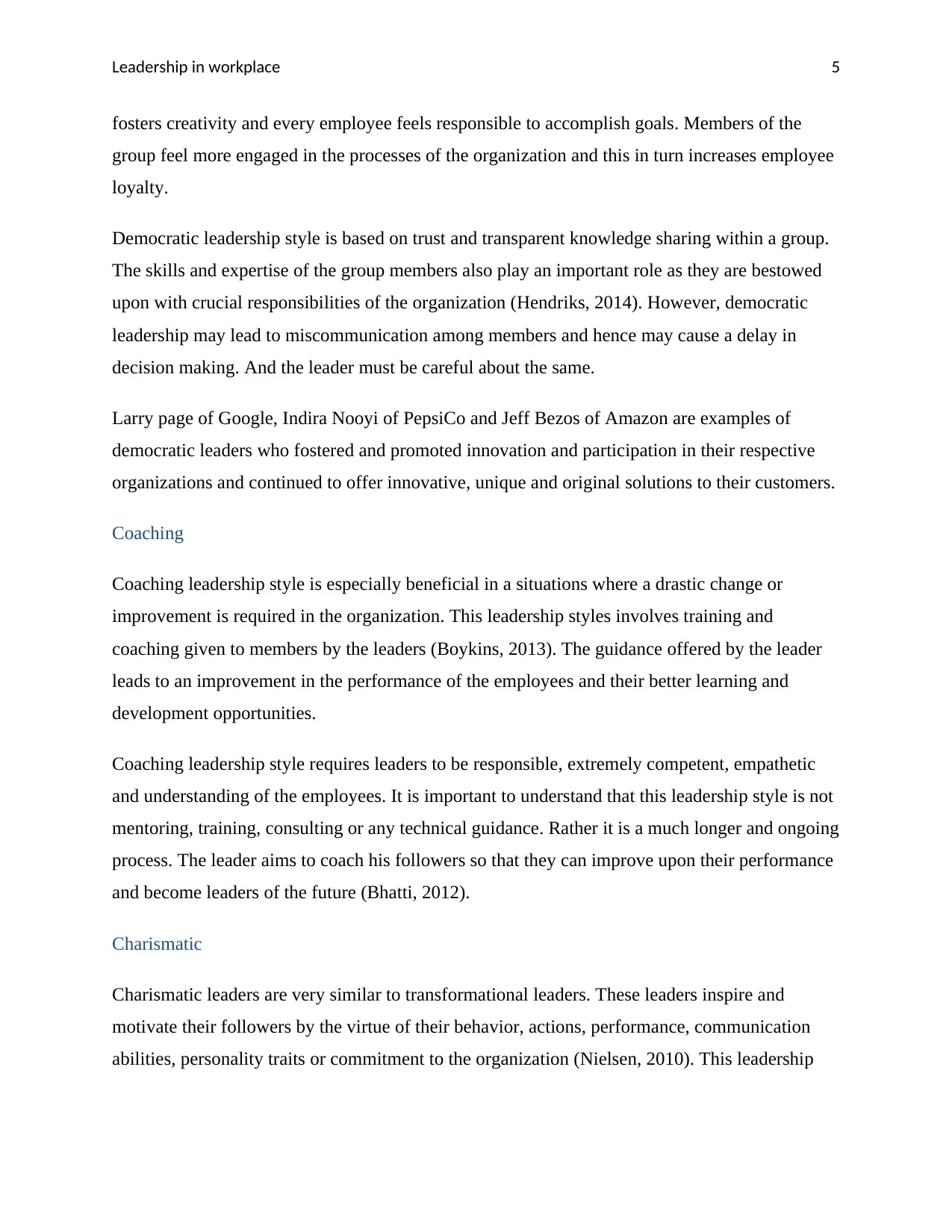
Leadership in workplace 5
fosters creativity and every employee feels responsible to accomplish goals. Members of the
group feel more engaged in the processes of the organization and this in turn increases employee
loyalty.
Democratic leadership style is based on trust and transparent knowledge sharing within a group.
The skills and expertise of the group members also play an important role as they are bestowed
upon with crucial responsibilities of the organization (Hendriks, 2014). However, democratic
leadership may lead to miscommunication among members and hence may cause a delay in
decision making. And the leader must be careful about the same.
Larry page of Google, Indira Nooyi of PepsiCo and Jeff Bezos of Amazon are examples of
democratic leaders who fostered and promoted innovation and participation in their respective
organizations and continued to offer innovative, unique and original solutions to their customers.
Coaching
Coaching leadership style is especially beneficial in a situations where a drastic change or
improvement is required in the organization. This leadership styles involves training and
coaching given to members by the leaders (Boykins, 2013). The guidance offered by the leader
leads to an improvement in the performance of the employees and their better learning and
development opportunities.
Coaching leadership style requires leaders to be responsible, extremely competent, empathetic
and understanding of the employees. It is important to understand that this leadership style is not
mentoring, training, consulting or any technical guidance. Rather it is a much longer and ongoing
process. The leader aims to coach his followers so that they can improve upon their performance
and become leaders of the future (Bhatti, 2012).
Charismatic
Charismatic leaders are very similar to transformational leaders. These leaders inspire and
motivate their followers by the virtue of their behavior, actions, performance, communication
abilities, personality traits or commitment to the organization (Nielsen, 2010). This leadership
fosters creativity and every employee feels responsible to accomplish goals. Members of the
group feel more engaged in the processes of the organization and this in turn increases employee
loyalty.
Democratic leadership style is based on trust and transparent knowledge sharing within a group.
The skills and expertise of the group members also play an important role as they are bestowed
upon with crucial responsibilities of the organization (Hendriks, 2014). However, democratic
leadership may lead to miscommunication among members and hence may cause a delay in
decision making. And the leader must be careful about the same.
Larry page of Google, Indira Nooyi of PepsiCo and Jeff Bezos of Amazon are examples of
democratic leaders who fostered and promoted innovation and participation in their respective
organizations and continued to offer innovative, unique and original solutions to their customers.
Coaching
Coaching leadership style is especially beneficial in a situations where a drastic change or
improvement is required in the organization. This leadership styles involves training and
coaching given to members by the leaders (Boykins, 2013). The guidance offered by the leader
leads to an improvement in the performance of the employees and their better learning and
development opportunities.
Coaching leadership style requires leaders to be responsible, extremely competent, empathetic
and understanding of the employees. It is important to understand that this leadership style is not
mentoring, training, consulting or any technical guidance. Rather it is a much longer and ongoing
process. The leader aims to coach his followers so that they can improve upon their performance
and become leaders of the future (Bhatti, 2012).
Charismatic
Charismatic leaders are very similar to transformational leaders. These leaders inspire and
motivate their followers by the virtue of their behavior, actions, performance, communication
abilities, personality traits or commitment to the organization (Nielsen, 2010). This leadership
⊘ This is a preview!⊘
Do you want full access?
Subscribe today to unlock all pages.

Trusted by 1+ million students worldwide
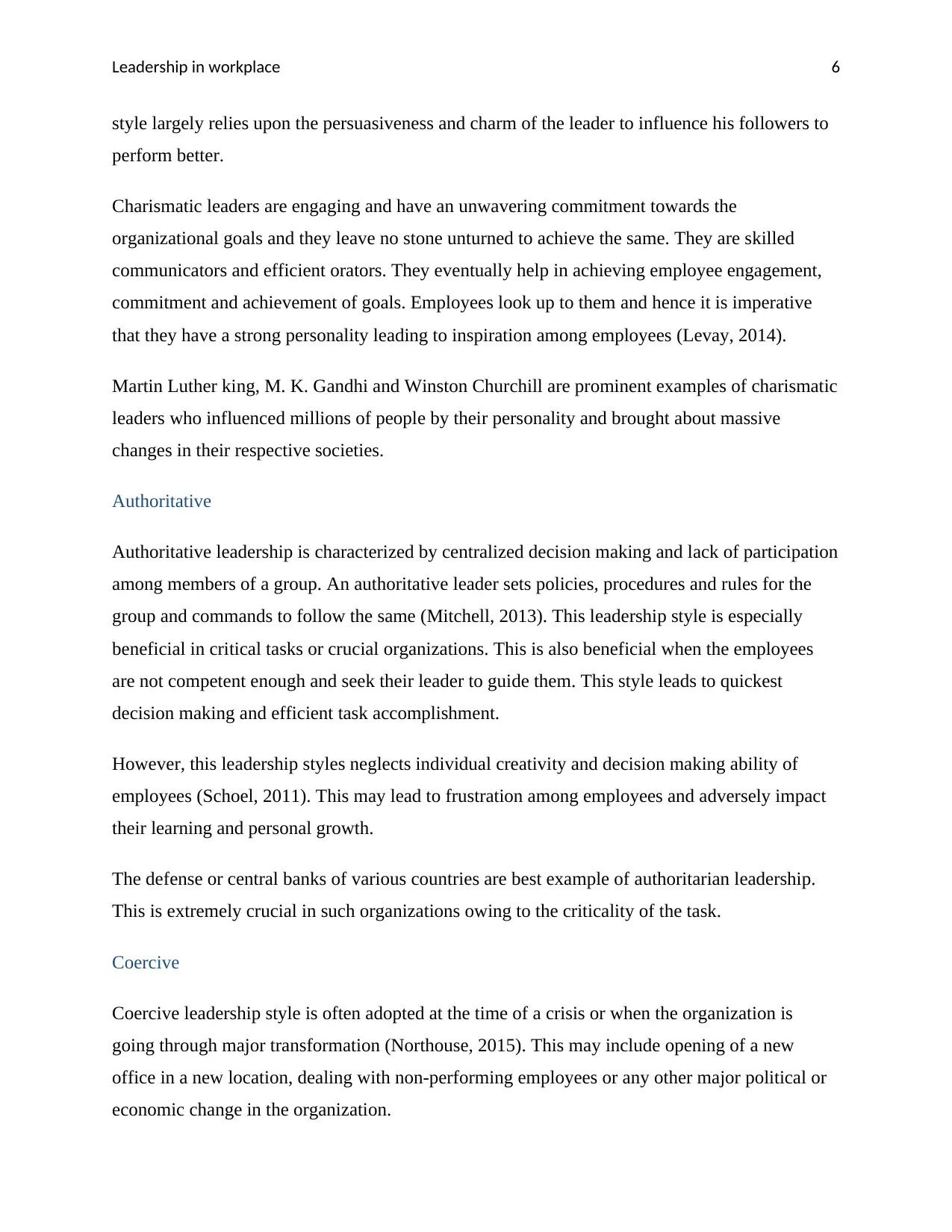
Leadership in workplace 6
style largely relies upon the persuasiveness and charm of the leader to influence his followers to
perform better.
Charismatic leaders are engaging and have an unwavering commitment towards the
organizational goals and they leave no stone unturned to achieve the same. They are skilled
communicators and efficient orators. They eventually help in achieving employee engagement,
commitment and achievement of goals. Employees look up to them and hence it is imperative
that they have a strong personality leading to inspiration among employees (Levay, 2014).
Martin Luther king, M. K. Gandhi and Winston Churchill are prominent examples of charismatic
leaders who influenced millions of people by their personality and brought about massive
changes in their respective societies.
Authoritative
Authoritative leadership is characterized by centralized decision making and lack of participation
among members of a group. An authoritative leader sets policies, procedures and rules for the
group and commands to follow the same (Mitchell, 2013). This leadership style is especially
beneficial in critical tasks or crucial organizations. This is also beneficial when the employees
are not competent enough and seek their leader to guide them. This style leads to quickest
decision making and efficient task accomplishment.
However, this leadership styles neglects individual creativity and decision making ability of
employees (Schoel, 2011). This may lead to frustration among employees and adversely impact
their learning and personal growth.
The defense or central banks of various countries are best example of authoritarian leadership.
This is extremely crucial in such organizations owing to the criticality of the task.
Coercive
Coercive leadership style is often adopted at the time of a crisis or when the organization is
going through major transformation (Northouse, 2015). This may include opening of a new
office in a new location, dealing with non-performing employees or any other major political or
economic change in the organization.
style largely relies upon the persuasiveness and charm of the leader to influence his followers to
perform better.
Charismatic leaders are engaging and have an unwavering commitment towards the
organizational goals and they leave no stone unturned to achieve the same. They are skilled
communicators and efficient orators. They eventually help in achieving employee engagement,
commitment and achievement of goals. Employees look up to them and hence it is imperative
that they have a strong personality leading to inspiration among employees (Levay, 2014).
Martin Luther king, M. K. Gandhi and Winston Churchill are prominent examples of charismatic
leaders who influenced millions of people by their personality and brought about massive
changes in their respective societies.
Authoritative
Authoritative leadership is characterized by centralized decision making and lack of participation
among members of a group. An authoritative leader sets policies, procedures and rules for the
group and commands to follow the same (Mitchell, 2013). This leadership style is especially
beneficial in critical tasks or crucial organizations. This is also beneficial when the employees
are not competent enough and seek their leader to guide them. This style leads to quickest
decision making and efficient task accomplishment.
However, this leadership styles neglects individual creativity and decision making ability of
employees (Schoel, 2011). This may lead to frustration among employees and adversely impact
their learning and personal growth.
The defense or central banks of various countries are best example of authoritarian leadership.
This is extremely crucial in such organizations owing to the criticality of the task.
Coercive
Coercive leadership style is often adopted at the time of a crisis or when the organization is
going through major transformation (Northouse, 2015). This may include opening of a new
office in a new location, dealing with non-performing employees or any other major political or
economic change in the organization.
Paraphrase This Document
Need a fresh take? Get an instant paraphrase of this document with our AI Paraphraser
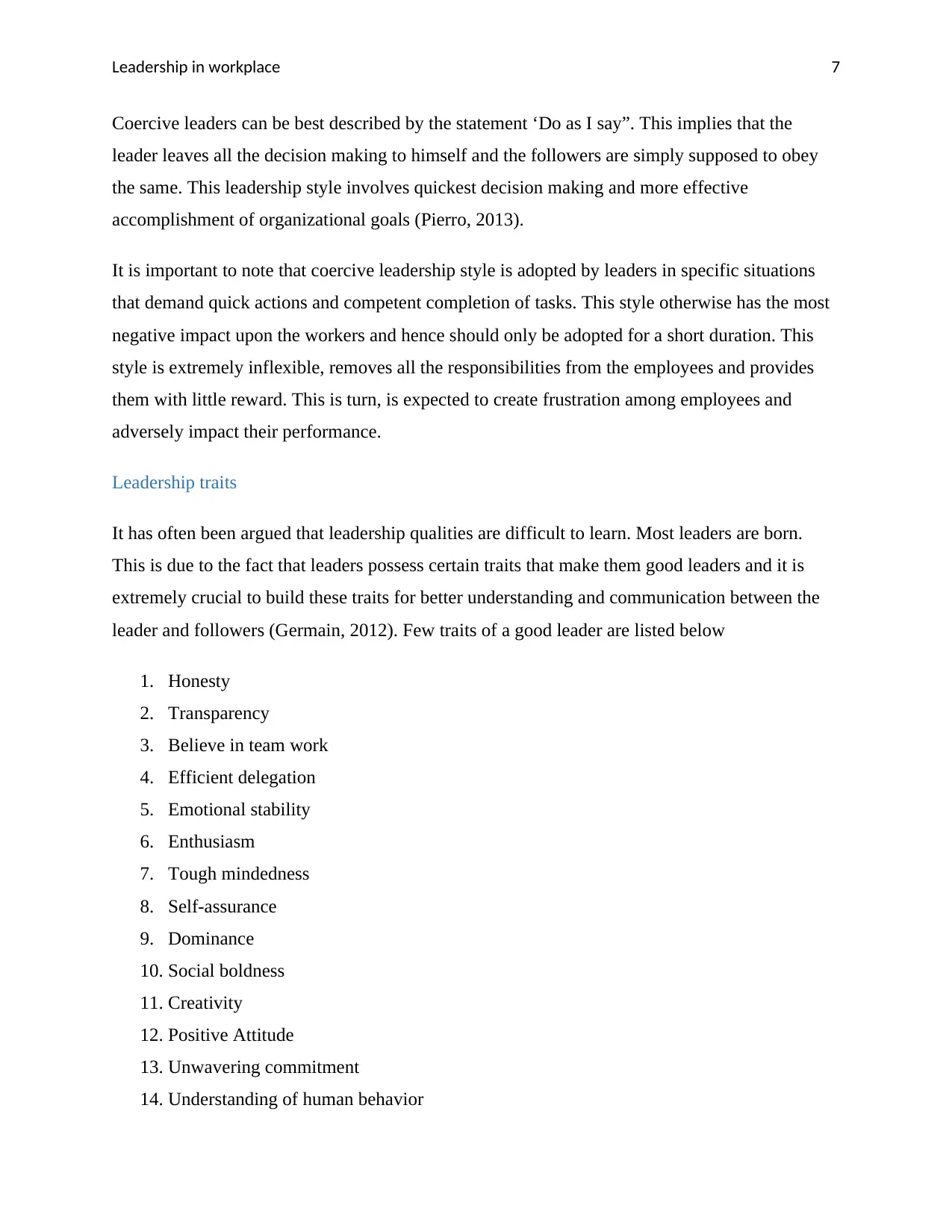
Leadership in workplace 7
Coercive leaders can be best described by the statement ‘Do as I say”. This implies that the
leader leaves all the decision making to himself and the followers are simply supposed to obey
the same. This leadership style involves quickest decision making and more effective
accomplishment of organizational goals (Pierro, 2013).
It is important to note that coercive leadership style is adopted by leaders in specific situations
that demand quick actions and competent completion of tasks. This style otherwise has the most
negative impact upon the workers and hence should only be adopted for a short duration. This
style is extremely inflexible, removes all the responsibilities from the employees and provides
them with little reward. This is turn, is expected to create frustration among employees and
adversely impact their performance.
Leadership traits
It has often been argued that leadership qualities are difficult to learn. Most leaders are born.
This is due to the fact that leaders possess certain traits that make them good leaders and it is
extremely crucial to build these traits for better understanding and communication between the
leader and followers (Germain, 2012). Few traits of a good leader are listed below
1. Honesty
2. Transparency
3. Believe in team work
4. Efficient delegation
5. Emotional stability
6. Enthusiasm
7. Tough mindedness
8. Self-assurance
9. Dominance
10. Social boldness
11. Creativity
12. Positive Attitude
13. Unwavering commitment
14. Understanding of human behavior
Coercive leaders can be best described by the statement ‘Do as I say”. This implies that the
leader leaves all the decision making to himself and the followers are simply supposed to obey
the same. This leadership style involves quickest decision making and more effective
accomplishment of organizational goals (Pierro, 2013).
It is important to note that coercive leadership style is adopted by leaders in specific situations
that demand quick actions and competent completion of tasks. This style otherwise has the most
negative impact upon the workers and hence should only be adopted for a short duration. This
style is extremely inflexible, removes all the responsibilities from the employees and provides
them with little reward. This is turn, is expected to create frustration among employees and
adversely impact their performance.
Leadership traits
It has often been argued that leadership qualities are difficult to learn. Most leaders are born.
This is due to the fact that leaders possess certain traits that make them good leaders and it is
extremely crucial to build these traits for better understanding and communication between the
leader and followers (Germain, 2012). Few traits of a good leader are listed below
1. Honesty
2. Transparency
3. Believe in team work
4. Efficient delegation
5. Emotional stability
6. Enthusiasm
7. Tough mindedness
8. Self-assurance
9. Dominance
10. Social boldness
11. Creativity
12. Positive Attitude
13. Unwavering commitment
14. Understanding of human behavior
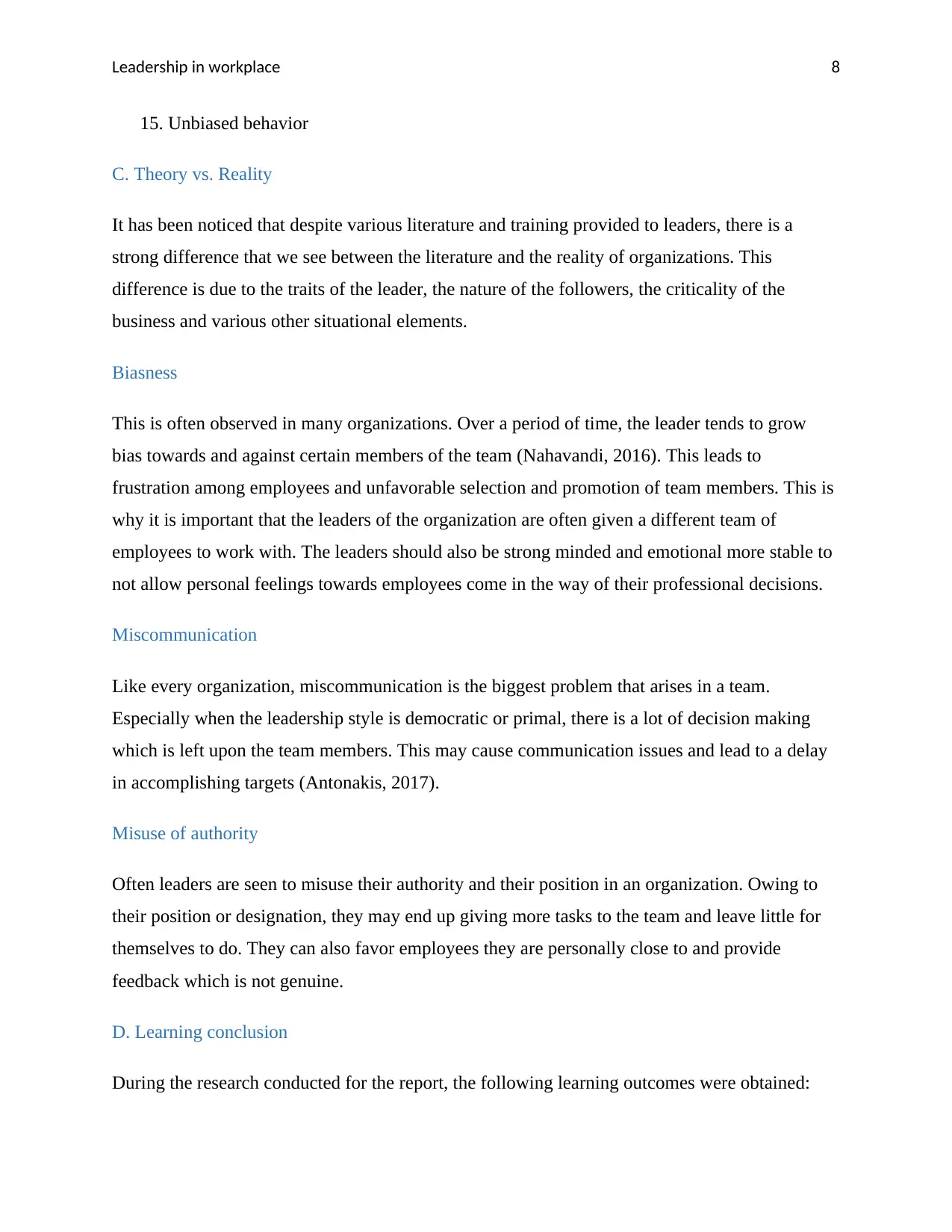
Leadership in workplace 8
15. Unbiased behavior
C. Theory vs. Reality
It has been noticed that despite various literature and training provided to leaders, there is a
strong difference that we see between the literature and the reality of organizations. This
difference is due to the traits of the leader, the nature of the followers, the criticality of the
business and various other situational elements.
Biasness
This is often observed in many organizations. Over a period of time, the leader tends to grow
bias towards and against certain members of the team (Nahavandi, 2016). This leads to
frustration among employees and unfavorable selection and promotion of team members. This is
why it is important that the leaders of the organization are often given a different team of
employees to work with. The leaders should also be strong minded and emotional more stable to
not allow personal feelings towards employees come in the way of their professional decisions.
Miscommunication
Like every organization, miscommunication is the biggest problem that arises in a team.
Especially when the leadership style is democratic or primal, there is a lot of decision making
which is left upon the team members. This may cause communication issues and lead to a delay
in accomplishing targets (Antonakis, 2017).
Misuse of authority
Often leaders are seen to misuse their authority and their position in an organization. Owing to
their position or designation, they may end up giving more tasks to the team and leave little for
themselves to do. They can also favor employees they are personally close to and provide
feedback which is not genuine.
D. Learning conclusion
During the research conducted for the report, the following learning outcomes were obtained:
15. Unbiased behavior
C. Theory vs. Reality
It has been noticed that despite various literature and training provided to leaders, there is a
strong difference that we see between the literature and the reality of organizations. This
difference is due to the traits of the leader, the nature of the followers, the criticality of the
business and various other situational elements.
Biasness
This is often observed in many organizations. Over a period of time, the leader tends to grow
bias towards and against certain members of the team (Nahavandi, 2016). This leads to
frustration among employees and unfavorable selection and promotion of team members. This is
why it is important that the leaders of the organization are often given a different team of
employees to work with. The leaders should also be strong minded and emotional more stable to
not allow personal feelings towards employees come in the way of their professional decisions.
Miscommunication
Like every organization, miscommunication is the biggest problem that arises in a team.
Especially when the leadership style is democratic or primal, there is a lot of decision making
which is left upon the team members. This may cause communication issues and lead to a delay
in accomplishing targets (Antonakis, 2017).
Misuse of authority
Often leaders are seen to misuse their authority and their position in an organization. Owing to
their position or designation, they may end up giving more tasks to the team and leave little for
themselves to do. They can also favor employees they are personally close to and provide
feedback which is not genuine.
D. Learning conclusion
During the research conducted for the report, the following learning outcomes were obtained:
⊘ This is a preview!⊘
Do you want full access?
Subscribe today to unlock all pages.

Trusted by 1+ million students worldwide
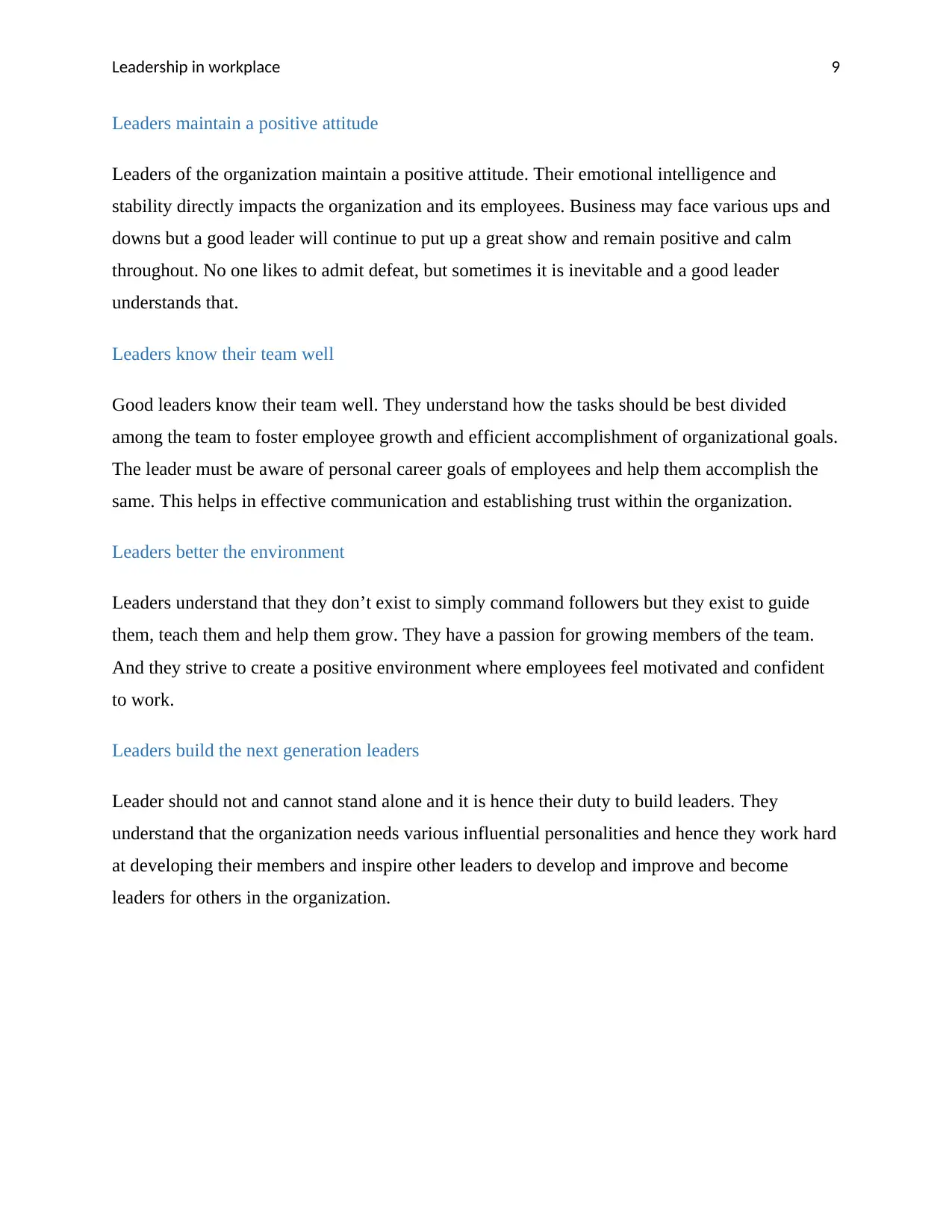
Leadership in workplace 9
Leaders maintain a positive attitude
Leaders of the organization maintain a positive attitude. Their emotional intelligence and
stability directly impacts the organization and its employees. Business may face various ups and
downs but a good leader will continue to put up a great show and remain positive and calm
throughout. No one likes to admit defeat, but sometimes it is inevitable and a good leader
understands that.
Leaders know their team well
Good leaders know their team well. They understand how the tasks should be best divided
among the team to foster employee growth and efficient accomplishment of organizational goals.
The leader must be aware of personal career goals of employees and help them accomplish the
same. This helps in effective communication and establishing trust within the organization.
Leaders better the environment
Leaders understand that they don’t exist to simply command followers but they exist to guide
them, teach them and help them grow. They have a passion for growing members of the team.
And they strive to create a positive environment where employees feel motivated and confident
to work.
Leaders build the next generation leaders
Leader should not and cannot stand alone and it is hence their duty to build leaders. They
understand that the organization needs various influential personalities and hence they work hard
at developing their members and inspire other leaders to develop and improve and become
leaders for others in the organization.
Leaders maintain a positive attitude
Leaders of the organization maintain a positive attitude. Their emotional intelligence and
stability directly impacts the organization and its employees. Business may face various ups and
downs but a good leader will continue to put up a great show and remain positive and calm
throughout. No one likes to admit defeat, but sometimes it is inevitable and a good leader
understands that.
Leaders know their team well
Good leaders know their team well. They understand how the tasks should be best divided
among the team to foster employee growth and efficient accomplishment of organizational goals.
The leader must be aware of personal career goals of employees and help them accomplish the
same. This helps in effective communication and establishing trust within the organization.
Leaders better the environment
Leaders understand that they don’t exist to simply command followers but they exist to guide
them, teach them and help them grow. They have a passion for growing members of the team.
And they strive to create a positive environment where employees feel motivated and confident
to work.
Leaders build the next generation leaders
Leader should not and cannot stand alone and it is hence their duty to build leaders. They
understand that the organization needs various influential personalities and hence they work hard
at developing their members and inspire other leaders to develop and improve and become
leaders for others in the organization.
Paraphrase This Document
Need a fresh take? Get an instant paraphrase of this document with our AI Paraphraser
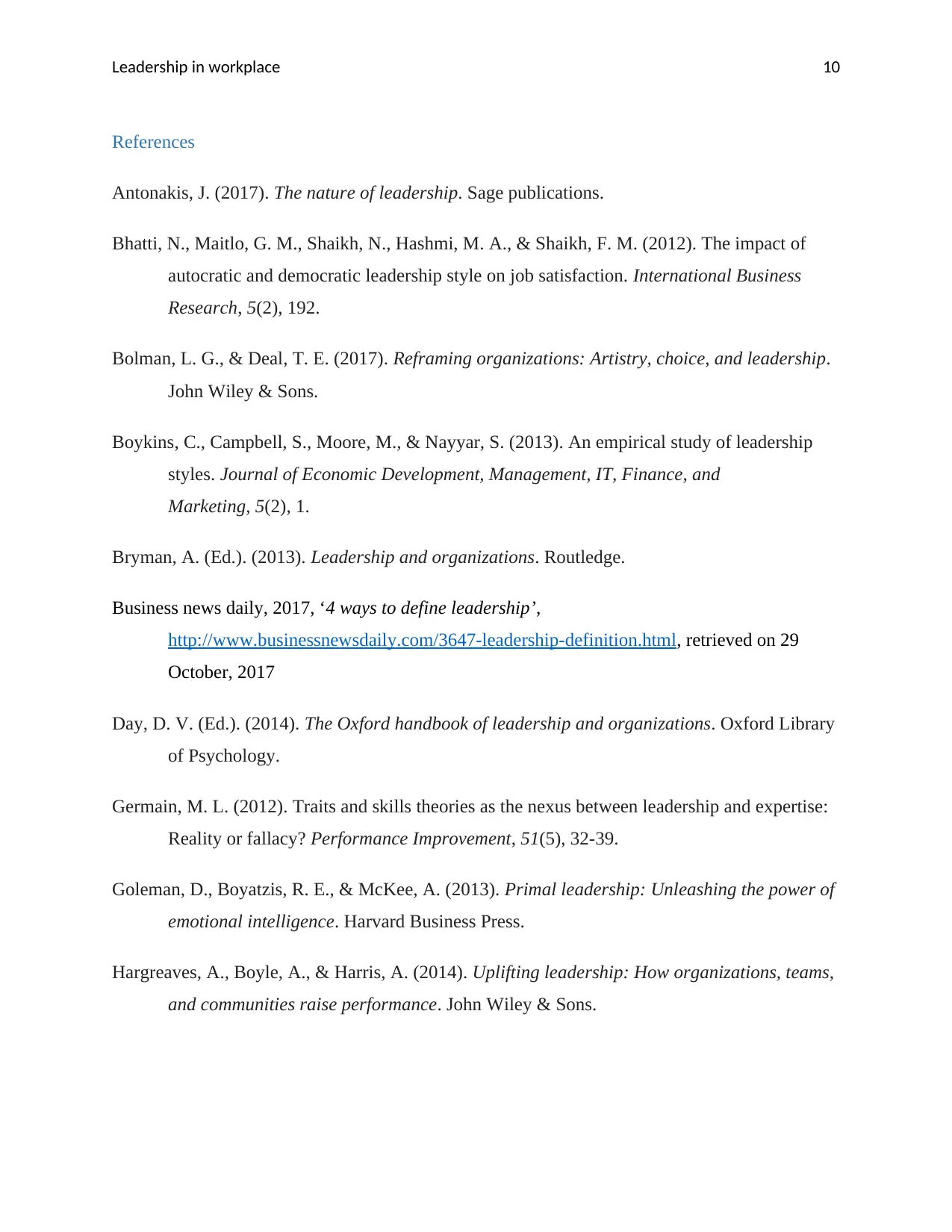
Leadership in workplace 10
References
Antonakis, J. (2017). The nature of leadership. Sage publications.
Bhatti, N., Maitlo, G. M., Shaikh, N., Hashmi, M. A., & Shaikh, F. M. (2012). The impact of
autocratic and democratic leadership style on job satisfaction. International Business
Research, 5(2), 192.
Bolman, L. G., & Deal, T. E. (2017). Reframing organizations: Artistry, choice, and leadership.
John Wiley & Sons.
Boykins, C., Campbell, S., Moore, M., & Nayyar, S. (2013). An empirical study of leadership
styles. Journal of Economic Development, Management, IT, Finance, and
Marketing, 5(2), 1.
Bryman, A. (Ed.). (2013). Leadership and organizations. Routledge.
Business news daily, 2017, ‘4 ways to define leadership’,
http://www.businessnewsdaily.com/3647-leadership-definition.html, retrieved on 29
October, 2017
Day, D. V. (Ed.). (2014). The Oxford handbook of leadership and organizations. Oxford Library
of Psychology.
Germain, M. L. (2012). Traits and skills theories as the nexus between leadership and expertise:
Reality or fallacy? Performance Improvement, 51(5), 32-39.
Goleman, D., Boyatzis, R. E., & McKee, A. (2013). Primal leadership: Unleashing the power of
emotional intelligence. Harvard Business Press.
Hargreaves, A., Boyle, A., & Harris, A. (2014). Uplifting leadership: How organizations, teams,
and communities raise performance. John Wiley & Sons.
References
Antonakis, J. (2017). The nature of leadership. Sage publications.
Bhatti, N., Maitlo, G. M., Shaikh, N., Hashmi, M. A., & Shaikh, F. M. (2012). The impact of
autocratic and democratic leadership style on job satisfaction. International Business
Research, 5(2), 192.
Bolman, L. G., & Deal, T. E. (2017). Reframing organizations: Artistry, choice, and leadership.
John Wiley & Sons.
Boykins, C., Campbell, S., Moore, M., & Nayyar, S. (2013). An empirical study of leadership
styles. Journal of Economic Development, Management, IT, Finance, and
Marketing, 5(2), 1.
Bryman, A. (Ed.). (2013). Leadership and organizations. Routledge.
Business news daily, 2017, ‘4 ways to define leadership’,
http://www.businessnewsdaily.com/3647-leadership-definition.html, retrieved on 29
October, 2017
Day, D. V. (Ed.). (2014). The Oxford handbook of leadership and organizations. Oxford Library
of Psychology.
Germain, M. L. (2012). Traits and skills theories as the nexus between leadership and expertise:
Reality or fallacy? Performance Improvement, 51(5), 32-39.
Goleman, D., Boyatzis, R. E., & McKee, A. (2013). Primal leadership: Unleashing the power of
emotional intelligence. Harvard Business Press.
Hargreaves, A., Boyle, A., & Harris, A. (2014). Uplifting leadership: How organizations, teams,
and communities raise performance. John Wiley & Sons.

Leadership in workplace 11
Harvard Business Review, 2001, ‘Primal leadership: the hidden driver of great performance’,
https://hbr.org/2001/12/primal-leadership-the-hidden-driver-of-great-performance,
retrieved on 29 October, 2017.
Hendriks, F., & Karsten, N. (2014). Theory of democratic leadership. Pp.’s Hart & R. Rhodes
(Eds.), Oxford handbook of political leadership, 41-56.
Levay, C. (2014). Charismatic leadership in resistance to change. The Leadership
Quarterly, 21(1), 127-143.
Mitchell, G. (2013). Selecting the best theory to implement planned change. Nursing
Management-UK, 20(1).
Nielsen, R., Marrone, J. A., & Slay, H. S. (2010). A new look at humility: Exploring the humility
concept and its role in socialized charismatic leadership. Journal of Leadership &
Organizational Studies, 17(1), 33-43.
Northouse, P. G. (2015). Leadership: Theory and practice. Sage publications.
Pierro, A., Raven, B. H., Amato, C., & Bélanger, J. J. (2013). Bases of social power, leadership
styles, and organizational commitment. International Journal of Psychology, 48(6),
1122-1134.
Puni, A., Ofei, S. B., & Okoe, A. (2014). The effect of leadership styles on firm performance in
Ghana. International Journal of Marketing Studies, 6(1), 177.
Schoel, C., Bluemke, M., Mueller, P., & Stahlberg, D. (2011). When autocratic leaders become
an option—Uncertainty and self-esteem predict implicit leadership preferences. Journal
of personality and social psychology, 101(3), 521.
Harvard Business Review, 2001, ‘Primal leadership: the hidden driver of great performance’,
https://hbr.org/2001/12/primal-leadership-the-hidden-driver-of-great-performance,
retrieved on 29 October, 2017.
Hendriks, F., & Karsten, N. (2014). Theory of democratic leadership. Pp.’s Hart & R. Rhodes
(Eds.), Oxford handbook of political leadership, 41-56.
Levay, C. (2014). Charismatic leadership in resistance to change. The Leadership
Quarterly, 21(1), 127-143.
Mitchell, G. (2013). Selecting the best theory to implement planned change. Nursing
Management-UK, 20(1).
Nielsen, R., Marrone, J. A., & Slay, H. S. (2010). A new look at humility: Exploring the humility
concept and its role in socialized charismatic leadership. Journal of Leadership &
Organizational Studies, 17(1), 33-43.
Northouse, P. G. (2015). Leadership: Theory and practice. Sage publications.
Pierro, A., Raven, B. H., Amato, C., & Bélanger, J. J. (2013). Bases of social power, leadership
styles, and organizational commitment. International Journal of Psychology, 48(6),
1122-1134.
Puni, A., Ofei, S. B., & Okoe, A. (2014). The effect of leadership styles on firm performance in
Ghana. International Journal of Marketing Studies, 6(1), 177.
Schoel, C., Bluemke, M., Mueller, P., & Stahlberg, D. (2011). When autocratic leaders become
an option—Uncertainty and self-esteem predict implicit leadership preferences. Journal
of personality and social psychology, 101(3), 521.
⊘ This is a preview!⊘
Do you want full access?
Subscribe today to unlock all pages.

Trusted by 1+ million students worldwide
1 out of 12
Related Documents
Your All-in-One AI-Powered Toolkit for Academic Success.
+13062052269
info@desklib.com
Available 24*7 on WhatsApp / Email
![[object Object]](/_next/static/media/star-bottom.7253800d.svg)
Unlock your academic potential
Copyright © 2020–2025 A2Z Services. All Rights Reserved. Developed and managed by ZUCOL.




